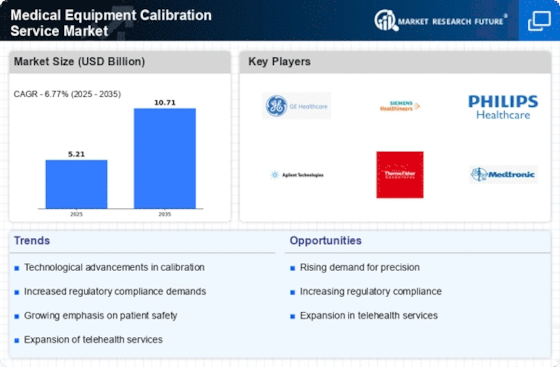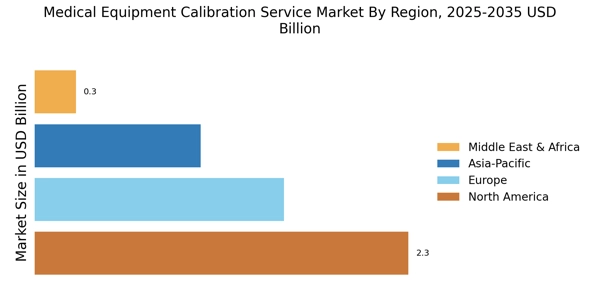Rising Focus on Patient Safety
Patient safety remains a critical concern within the Medical Equipment Calibration Service Market. Healthcare organizations are increasingly prioritizing the maintenance of medical equipment to prevent errors that could jeopardize patient health. Calibration services play a vital role in ensuring that equipment functions correctly, thereby minimizing the likelihood of adverse events. According to recent data, approximately 30% of medical errors are attributed to equipment malfunction. This statistic underscores the necessity for regular calibration, as healthcare facilities aim to comply with safety standards and enhance overall patient care. The growing awareness of patient safety is likely to propel the demand for calibration services.
Expansion of Home Healthcare Services
The Medical Equipment Calibration Service Market is witnessing growth due to the expansion of home healthcare services. As more patients receive care in their homes, the demand for portable medical devices increases. These devices require regular calibration to ensure their accuracy and reliability. The home healthcare market is projected to grow at a rate of 8% annually, which will likely drive the need for calibration services tailored to home-use equipment. This trend indicates a shift in healthcare delivery models, emphasizing the importance of maintaining equipment standards even outside traditional healthcare settings.
Increasing Demand for Accurate Diagnostics
The Medical Equipment Calibration Service Market is experiencing a surge in demand for accurate diagnostics. As healthcare providers strive to enhance patient outcomes, the need for precise and reliable medical equipment becomes paramount. Calibration services ensure that diagnostic devices, such as imaging machines and laboratory instruments, operate within specified tolerances. This demand is reflected in the projected growth of the calibration services market, which is expected to reach USD 5 billion by 2026. The emphasis on accuracy in diagnostics not only improves patient safety but also reduces the risk of misdiagnosis, thereby driving the need for regular calibration services.
Technological Innovations in Medical Equipment
The Medical Equipment Calibration Service Market is significantly influenced by technological innovations in medical devices. As new technologies emerge, the complexity of medical equipment increases, necessitating advanced calibration techniques. Innovations such as digital imaging and telemedicine require precise calibration to ensure optimal performance. The market for calibration services is projected to grow at a compound annual growth rate of 7% over the next five years, driven by the introduction of sophisticated medical devices. This trend indicates that as technology evolves, the demand for specialized calibration services will likely expand, ensuring that healthcare providers can deliver high-quality care.
Regulatory Standards and Compliance Requirements
Regulatory standards play a crucial role in shaping the Medical Equipment Calibration Service Market. Healthcare facilities are mandated to adhere to strict regulations regarding the maintenance and calibration of medical equipment. Compliance with these standards is essential to avoid penalties and ensure the safety of patients. The increasing number of regulations, such as those set forth by health authorities, is driving the demand for calibration services. Facilities that fail to comply may face significant financial repercussions, thus incentivizing them to invest in regular calibration. This regulatory landscape is expected to continue influencing the market positively.


















Leave a Comment